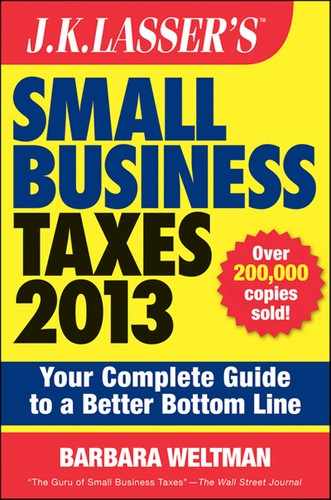Paying Taxes
There are several ways to pay taxes: By check, by transferring payment using the Electronic Federal Tax Payment System (EFTPS), or by charging payment to a major credit card.
Paying by Check
Most small business owners can pay their tax bill via check made payable to the United States Treasury. Remember that the bulk of the taxes should have been paid through estimated taxes; the check that accompanies the return should be modest.
Corporations cannot pay their income taxes by writing a check to accompany their tax return. They must pay amounts owed by depositing them with an authorized depository (explained below) or by transferring funds through EFTPS.
Paying Taxes Online
Some businesses must deposit their taxes through the Electronic Federal Tax Payment System (EFTPS) while others may choose to do so. EFTPS processes over 100 million transactions per year, totaling nearly $2 trillion, with an error rate of 0.18%. Under this payment method you authorize the transfer of funds from your bank account by using your telephone or personal computer. This payment method can be used whether or not returns are filed electronically and enables you to designate up to 120 days in advance the amount of payment to be made and the time of payment. As long as the transfer is initiated at least 1 business day before the due date of the deposit, the electronic fund transfer is considered timely.
Required Use of EFTPS
More than 97.5% of all federal tax deposits are now made electronically. Starting January 1, 2011, the use of federal tax coupons allowing deposits to be made at certain banks has been eliminated; all deposits (with some exceptions) must be made using EFTPS.
Payment can be made with the tax return and is not required to be deposited electronically if employment taxes are less than $2,500 per pay period.
You can enroll online at www.eftps.gov. If you prefer to submit a paper application, file Form 9779, EFTPS Business Enrollment Form, with the EFTPS Enrollment Processing Center (it can take several weeks to process a paper application).
Voluntary Use of EFTPS
Even if you are not required to use EFTPS, you may wish to do so—for convenience. You initiate payment so you remain in control of your funds until you want them disbursed to the government. You receive an acknowledgment number as a record of your payment.
You may voluntarily participate in EFTPS. To obtain more information on EFTPS or to enroll in the system, call (800) 555-4477 or (800) 945-8400. If you enroll, you can use the Internet or receive free Windows-based software for use on your PC. You also receive a PIN to use when making payments.
You can update existing passwords (to make them more secure) at “My Profile” at www.eftps.gov.
Electronic Transfer Payment Methods
There are different ways you can make an electronic transfer of funds to the government:
- Through EFTPS-OnLine at www.eftps.gov. This is a secured web site that individuals and businesses can use to pay taxes through the Internet. After enrolling online, you’ll receive a confirmation kit by mail, including instructions for obtaining your password (a PIN number is mailed separately). Payments can be scheduled in advance and even canceled, with instant acknowledgments to confirm transactions.
- Directly to EFTPS through your personal computer or telephone. You choose the automated clearing house (ACH) debit method when you enroll. Then, when you want to make a payment, you instruct EFTPS to transfer funds from your account to the U.S. Treasury.
- Through your bank or other financial institution through its payment service. You choose the ACH credit method when you enroll and follow the bank’s instructions on how to direct payment. Before designating a particular financial institution, check whether they can accommodate this payment method. Also ask about any fees or other charges for using this payment method.
If you use a payroll company to process your payroll, you may also authorize them to pay your employment taxes. Special enrollment rules for EFTPS apply in this case. You can also enroll separately so you keep the flexibility of making your own electronic payments.
Credit Card Charges
Businesses can pay taxes via credit card (American Express, Discover, MasterCard, or Visa) in some, but not all, instances. Balances owed with respect to employment tax returns (Forms 940, 941, and 944) can be charged to a credit card. However, federal tax deposits cannot be made by credit card.
Taxes owed on income tax returns of sole proprietors and owners of pass-through entities on Form 1040 can also be charged to a credit card.
As of now, taxes owed on Form 1120 or Form 1120S (in those limited situations where an S corporation owes tax) cannot be charged to a credit card. This could change in the future.
There are only 3 credit card processors authorized by the IRS to process tax payments:
These companies charge a convenience fee (currently up to 2.35% of the amount charged); the IRS does not impose any additional cost for charging taxes.
Late Payment Penalties
If you fail to pay the taxes due on time, you can be subject to late payment penalties and interest on the outstanding amount. Taxes must be paid in full by the due date of the return to avoid penalties and interest. Obtaining an extension of time to file the return does not give you more time to pay your taxes.
The penalty is 0.5% of the tax due, per month, with a maximum of 25%. In addition, interest is charged at the IRS interest rate, which adjusts quarterly. For news releases of IRS quarterly interest rates, go to www.irs.gov and search “news releases, and fact sheet archives.
The penalty may be waived if you can show that lateness was due to reasonable cause and not to willful neglect.
